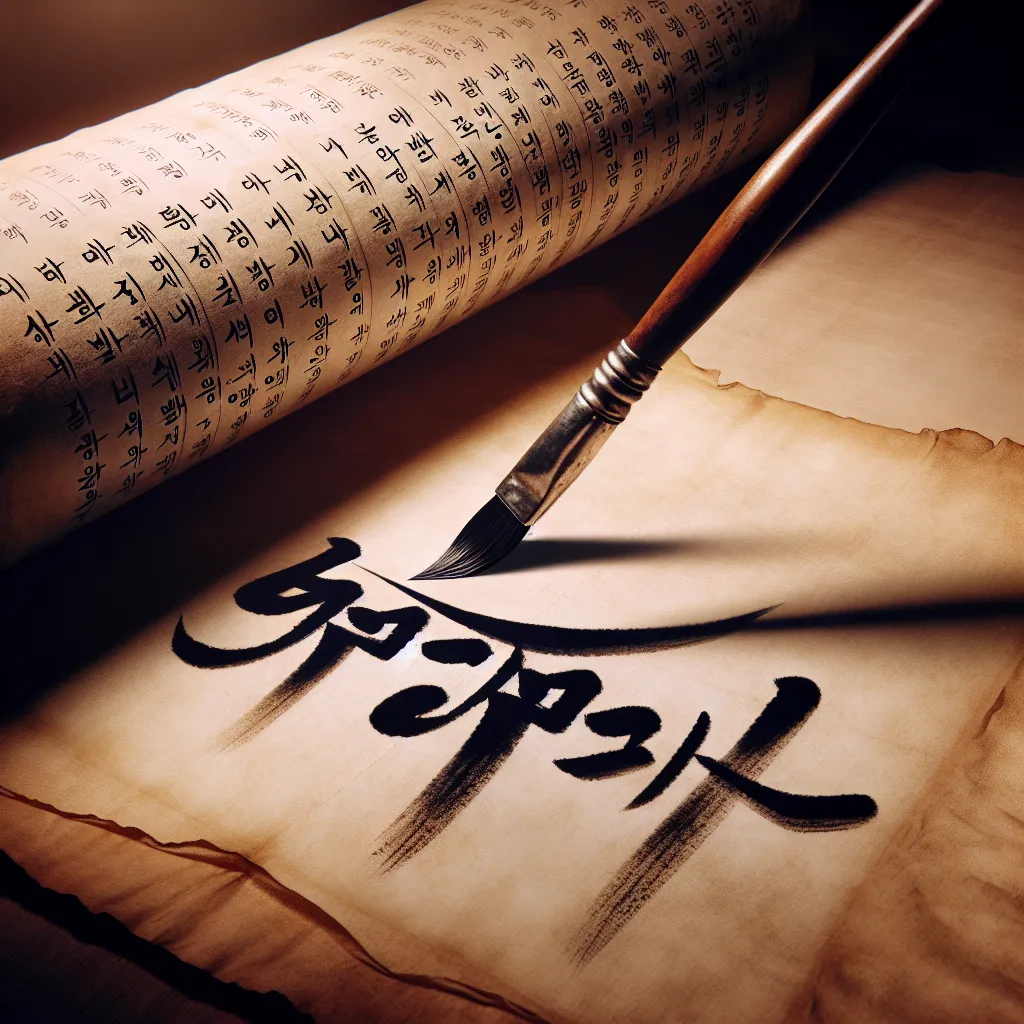Hangul, the unique alphabet of Korea, has a fascinating origin story that sets it apart from other writing systems. Its distinctive features make it not only visually appealing but also incredibly efficient. As Hangul evolved over the centuries, it retained its essence while adapting to modern needs. Understanding the importance of Hangul goes beyond just linguistic appreciation; it is a symbol of Korean identity and cultural pride. In this blog post, we will delve deeper into the history, characteristics, and significance of Hangul, shedding light on why it remains a cherished aspect of Korean heritage.

Origin of Hangul
The origin of Hangul, the unique alphabet of Korea, dates back to the 15th century. King Sejong the Great, the fourth king of the Joseon Dynasty, recognized the limitations of the existing writing system, which was based on Chinese characters. In 1443, he commissioned a group of scholars to create a new writing system that would be easy to learn and accessible to all, regardless of social status.
The Development of Hangul
The scholars, led by the brilliant linguist Jeong Inji, worked tirelessly to develop Hangul. They based the alphabet on the principles of phonetics, with each character representing a sound in the Korean language. The alphabet was designed to be simple and logical, with each character constructed from basic strokes that mimic the shape of the mouth when making the corresponding sound.
Did you know that Hangul consists of 14 consonants and 10 vowels? The consonants are based on the shape of the speech organs when producing the sounds, while the vowels are derived from three fundamental shapes: a horizontal line for the sky, a vertical line for a man, and a dot for the earth. This philosophical approach to design reflects the deep connection between language and nature in Korean culture.
Acceptance and Impact
When Hangul was officially promulgated in 1446, it was met with resistance from the aristocracy who viewed it as a threat to the status quo. However, King Sejong firmly believed in the power of Hangul to promote literacy and communication among his people. Over time, Hangul gained acceptance and became an integral part of Korean culture and identity.
The creation of Hangul revolutionized literacy in Korea, making it one of the most literate countries in the world. Its scientific and systematic design has been praised by linguists and scholars globally, highlighting its significance as a cultural heritage and a symbol of national pride.
In conclusion, the origin of Hangul is a testament to the visionary leadership of King Sejong the Great and the dedication of the scholars who developed this innovative writing system. Hangul stands as a unique and enduring symbol of Korea’s linguistic and cultural heritage, embodying the spirit of innovation and inclusivity that continues to inspire generations to come.
Distinctive Features of Hangul
Hangul, the Korean alphabet, stands out for its unique and innovative features. Designed in the 15th century under the reign of King Sejong the Great, Hangul is known for its scientific and systematic structure. Unlike many other writing systems, Hangul is phonetic, with each character representing a specific sound. This phonetic nature makes it incredibly easy to learn and master, with only 24 basic letters to memorize.
Organization into Syllabic Blocks
One of the most distinctive features of Hangul is its organization into syllabic blocks. Each block consists of two to five letters arranged in a square or rectangular shape. This design reflects the natural shape of the mouth when producing sounds, making it intuitive and visually appealing. Additionally, the systematic arrangement of consonants and vowels within each block allows for efficient and logical writing.
Scientific Approach to Representing Sounds
Furthermore, Hangul is praised for its scientific approach to representing sounds. The shapes of the letters are based on the physical articulation of sounds, making it a highly logical and consistent writing system. This scientific foundation sets Hangul apart from many other alphabets and contributes to its ease of use and clarity.
Efficiency and Cultural Significance
In terms of efficiency, Hangul is unmatched. The alphabet was specifically designed to be easy to learn and use, with a focus on maximizing literacy among the Korean population. The simplicity of the characters, combined with the logical organization of syllabic blocks, makes Hangul a highly efficient writing system that can be quickly mastered by learners of all ages.
Moreover, Hangul has a rich cultural significance for the Korean people. It is not just a means of communication, but a symbol of national pride and identity. The creation of Hangul was a revolutionary act that empowered the Korean people and promoted literacy and education. To this day, Hangul remains a source of pride and a testament to the ingenuity and creativity of the Korean nation.
In conclusion, the distinctive features of Hangul, including its phonetic nature, syllabic block organization, scientific design, efficiency, and cultural significance, make it a truly unique and remarkable writing system. Its impact on Korean society and culture cannot be overstated, and its legacy continues to inspire admiration and awe. Hangul truly stands as a testament to the power of language to shape and define a nation. 🇰🇷
Evolution of Hangul
Hangul, the unique Korean alphabet, has a fascinating evolution that sets it apart from other writing systems. Created in the 15th century under the reign of King Sejong the Great, Hangul was designed to be easy to learn and accessible to all, regardless of social status. This innovative script consists of 24 letters, including 14 consonants and 10 vowels, arranged in a systematic way to form syllables.
The creation of Hangul
Hangul was a revolutionary step towards literacy in Korea. Before its introduction, Chinese characters were predominantly used for writing, making it difficult for the common people to learn to read and write. Hangul’s simplicity and phonetic nature made it a powerful tool for spreading literacy and knowledge throughout the Korean peninsula.
Hangul’s design
Hangul’s design was based on the principles of yin and yang, with consonants representing the physical form of the speech organs used to produce sounds, and vowels symbolizing the sky, earth, and human beings. This philosophical foundation gave Hangul a deep cultural significance and a unique aesthetic appeal.
Changes over time
Over the centuries, Hangul has undergone minor modifications to adapt to changes in pronunciation and grammar. These changes have helped to maintain the relevance and usability of the script in modern times, ensuring that Hangul remains a vibrant and living writing system.
Global significance
Today, Hangul is not only used in South Korea but also in North Korea, where it plays a crucial role in preserving the Korean language and cultural identity. Its inclusion in the UNESCO Intangible Cultural Heritage list in 2009 further solidified its importance on the global stage.
In conclusion, the evolution of Hangul reflects the resilience and adaptability of the Korean people. From its humble beginnings to its current status as a symbol of national pride, Hangul continues to inspire and connect people through the power of language and culture. Its legacy serves as a testament to the enduring value of innovation and creativity in shaping the world we live in today.
Importance of Hangul
In the realm of linguistics, Hangul stands out as a remarkable feat of human ingenuity. Designed by King Sejong the Great in the 15th century, this unique Korean alphabet revolutionized literacy in Korea. With its scientific and systematic structure, Hangul is celebrated for its efficiency and accessibility, enabling even the most novice learners to grasp its intricacies with ease. 🌟
The Cultural Identity of Hangul
The significance of Hangul extends beyond its mere function as a writing system; it embodies the cultural identity and heritage of the Korean people. 🇰🇷 Its creation reflects a deep commitment to education and empowerment, as it was developed to ensure that all members of society could communicate effectively. The impact of Hangul on Korean society cannot be overstated, as it has played a pivotal role in shaping the nation’s history and fostering a sense of unity among its people.
Linguistic Significance
From a linguistic perspective, Hangul‘s phonetic design sets it apart from other writing systems. Each character represents a unique sound, allowing for precise pronunciation and reducing ambiguity in written communication. This phonemic feature has contributed to the preservation of the Korean language and facilitated its evolution over the centuries. 📚
International Recognition
Moreover, the simplicity and elegance of Hangul have garnered international acclaim, with UNESCO recognizing it as a Masterpiece of the Oral and Intangible Heritage of Humanity. This prestigious designation underscores the global significance of Hangul and highlights its enduring legacy as a symbol of cultural pride and linguistic excellence. 🏆
Role in Contemporary Society
In contemporary society, Hangul continues to play a vital role in promoting literacy and education in Korea and beyond. Its user-friendly design has made it a model for language learning programs worldwide, inspiring learners of all ages to engage with the Korean language and appreciate its rich literary tradition. 📖
In conclusion, the importance of Hangul transcends its practical utility as an alphabet; it embodies the spirit of innovation, inclusivity, and cultural heritage. As we celebrate the enduring legacy of Hangul, let us recognize its profound impact on Korean society and its invaluable contribution to the world of linguistics. 🌏 Let us cherish Hangul as a testament to the power of language to unite, inspire, and empower individuals across generations. 🌟
In conclusion, the Hangul alphabet stands as a testament to the ingenuity and foresight of its creators. Its unique origin, distinctive features, and continuous evolution showcase the depth of Korean culture and language. The importance of Hangul cannot be overstated, as it not only preserves the Korean identity but also serves as a symbol of national pride and unity. As we continue to appreciate and study Hangul, we gain a deeper understanding of the rich heritage and linguistic excellence of Korea. Its significance transcends borders and time, making it a truly remarkable script in the world of alphabets.
